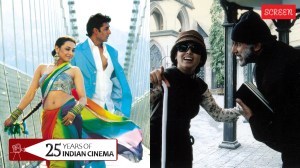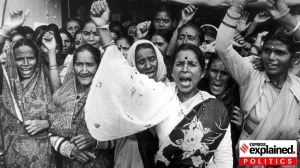
But what is a ‘masala’ film? And why does this genre matter so much to audiences, critics and the film industry?
Story continues below this ad
What are ‘masala’ films?
Simply put, a ‘masala’ film has wildly different elements thrown in together (similar to the way spices are combined in Indian cooking) to form a coherent narrative, with music and choreographed dance sequences comprising a major part of the runtime. Picture this: an emotional scene between a widowed mother and her young children is followed by a raunchy item number featuring the film’s villain, which is then followed by a college romance sub-plot, and then an action sequence showcasing the male protagonist and villain number 2. By the time the film ends, all of this has come together for a harmonious medley of flavours.
Indian Popular Cinema: A Narrative of Cultural Change, written by K Gokulsing and Wimal Dissanayake, postulates that the conventions of a ‘masala’ film have been shaped by historical art forms. First and foremost are the Hindu epics Mahabharata and Ramayana, which rely heavily on multiple side characters, their storylines, flashbacks, and sub-plots. Second are ancient Sanskrit dramas, or ‘natyas’ (examples include Kalidas’s Abhijnanashakuntalam and Sudraka’s Mrchhkatika). These emphasised the utilisation of songs and dance to create highly stylised spectacles, seemingly to maximise entertainment as well as emotional responses of the audience.
Third come indigenous folk theatre forms of India, ranging from the Harikatha traditions of the Telugu states to Uttar Pradesh’s Ramleelas. The fourth influence, according to Gokulsing and Dissanayake, comes from Parsi theatre, which contained elements of fantasy, music and dance woven into realistic dialogue and melodrama. “The Parsi plays contained crude humour, melodious songs and music, sensationalism and dazzling stagecraft,” they write.
How did Bollywood get ‘masala-fied’?
By and large, the consensus is that Yaadon Ki Baarat (1973) was the first ‘masala’ movie to have come out of the Hindi film industry. The director, Nasir Hussain, and the writers Salim Khan and Javed Akhtar (Salim-Javed), are now considered pioneers in popularising the format of a typical ‘masala’ entertainer, full of plot twists, heavy emotions, action sequences, comedic sub-plots, and of course, intricately composed and choreographed dance numbers.
Story continues below this ad
 With long-lost brothers, revenge, and romance, Yaadon Ki Baraat packed quite a punch. (Photo: YouTube)
With long-lost brothers, revenge, and romance, Yaadon Ki Baraat packed quite a punch. (Photo: YouTube)
Salim-Javed would go on to write some of the most seminal works of masala in Bollywood: a few examples are Sholay (1975), directed by Ramesh Sippy which routinely features in ‘best of Bollywood’ lists; Deewaar (1975), directed by Yash Chopra and one of the most iconic ‘Angry Young Man’ movies of the 1970s; Don (1978), directed by Chandra Barot and the inspirer of remakes in different languages; and Mr India (1987), directed by Shekhar Kapur and which could be considered one of the few science fiction ‘masala’ movies.
Why does masala matter?
The simplest answer: ‘masala’ movies are made to specifically cater to a large section of people, since they contain so many different elements that something will appeal to someone, from family audiences to ‘angry young men’. This wide-scale appeal could potentially translate to big profits for producers, plus fame for the director, cast and crew.
Further, if ‘masala’ movies choose to deliver a social ‘message’, they are potentially delivering that message to a wider audience than an ‘arthouse’ film could.
Masala movies are also how the Indian film industries, specifically Hindi, Tamil and Telugu, have become popular globally. The Mithun Chakraborty-starrer Disco Dancer (1982) still enjoys a fan-base in China and Russia, Rajinikanth’s Muthu (1995) started off a fandom wave for the superstar in Japan, and the S S Rajamouli directorial RRR (2022) set the American box office on fire and won the Best Song award at the Oscars.
Story continues below this ad
While Indian films were popular before the 1970s too, it can’t be denied that ‘masala’ films play a strong role in how our movies are perceived across the world.
Can Bollywood really not make masala films anymore?
Post the economic liberalisation of 1991, the themes Hindi films grappled with started changing (just like almost everything else in Indian society). Hindi films also started dealing with the Indian diaspora, and several successful movies from this period had them as the leads (the most famous example being the 1995 film Dilwale Dulhania Le Jayenge, credited as the longest-running Hindi movie of all time).
With increasing exposure to Western media, there was a slow and steady shift in aesthetic sensibilities too— the 2000s saw the rise of the term ‘multiplex film’, referring to movies that were made keeping a niche audience in mind, as opposed to the tent pole ‘masala’ films.
 Dilwale Dulhania Le Jayenge was Bollywood’s grand reach-out to the diaspora audience. (Photo: YiuTube)
Dilwale Dulhania Le Jayenge was Bollywood’s grand reach-out to the diaspora audience. (Photo: YiuTube)
This did not mean that masala movies completely faded away from pop culture. The South Indian industries (Kannada, Malayalam, Tamil and Telugu) still had a substantial number of ‘masala’ films, and Bollywood had a few stars who could be counted on to deliver on the same front (Salman Khan, Akshay Kumar and Ajay Devgn being the prime examples). The Kannada, Tamil and Telugu industries soon took over Bollywood as the biggest supplier of ‘masala’, though, and with access to the Internet getting easier every year, Hindi dubbed versions of these films became popular with the north Indian audiences on YouTube.
Story continues below this ad
Which brings us back to the man of the moment, Allu Arjun. His fandom in the Hindi heartland is so huge that there were reports of single-screen theatres in small towns reopening after the Covid-19 induced pandemic simply on the strength of his Telugu films being dubbed into Hindi. Another ‘pan-Indian’ success, KGF (both parts), starring Kannada star Yash, also dealt with an ‘angry young man’ and his journey to the top— both film franchises contributed significantly to the discourse on whether Bollywood has lost its ‘masala’.
Another complaint against many recent Bollywood ‘masala’ films is that they take the audience for granted, regurgitating old tropes without emotional or intellectual sincerity. Examples of this include Cirkus (2022) and Singham Again (2024) directed by Rohit Shetty; Bade Miyan Chote Miyan (2024), starring Akshay Kumar and Tiger Shroff; and Salman Khan’s Kisi Ka Bhai Kisi Ki Jaan (2023).



 With long-lost brothers, revenge, and romance, Yaadon Ki Baraat packed quite a punch. (Photo: YouTube)
With long-lost brothers, revenge, and romance, Yaadon Ki Baraat packed quite a punch. (Photo: YouTube) Dilwale Dulhania Le Jayenge was Bollywood’s grand reach-out to the diaspora audience. (Photo: YiuTube)
Dilwale Dulhania Le Jayenge was Bollywood’s grand reach-out to the diaspora audience. (Photo: YiuTube)




































